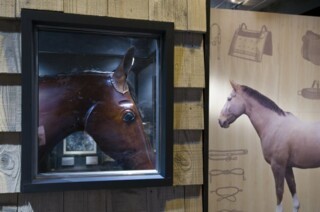Once Upon a Wartime
Jenny Turner · At the Imperial War Museum
I haven’t seen the play of War Horse, and never got to the end of the novel either: my son had Private Peaceful, another of Michael Morpurgo’s First World War books, as a bedtime story, and it was so sad and full of injustice – and dragged out, chapter after bleeding chapter, night after night after night – I am just relieved that now he can read these terrible documents, should he wish to, without my help. In War Horse (1982), it’s 1914 and Joey’s owner sells him to the cavalry– and that’s all you need to know, really. The book is one of the five ‘classic war stories for children’ that the Imperial War Museum aims to ‘bring to life’ in its new exhibition, Once Upon a Wartime. To help bring War Horse to life there’s a vicious (and authentic) steel rapier, and film of mud and bombs and corpses. And the most amazing full-size wooden statue of a horse, but with legs like a table’s – soldiers used it, apparently, to learn about tacking up. A letter from the Hewlett children begs Lord Kitchener not to take Old Betty, the family mare: ‘Dad says she is going to be a mother early next year.’
Small boys I know love visiting the Imperial War Museum – the Spitfire, the V2 rocket, the special fart smells in the fibreglass trench. And I love the IWM too, of course, though I’m always fascinated by how completely ideological an experience it is. If your family is, like mine, largely white and Britain-dwelling for as long as anyone can remember, the emotions unleashed by the 1940s House, for example – wireless in the lounge, tiled lino on the bathroom floor – can be overwhelming: the memories, the evocations of phoney belonging, the death gathering in the corners, like a dustball missed by your houseproud grandma, which in years to come you will remember as the first sign you should have noticed that she was beginning to get ill.
Only then, it all got even more confusing, as the whole 1940s thing got trendy – cute facsimile books about Digging for Victory, that infernal ‘Keep Calm and Carry On’ poster. The Children’s War show,which is where you’ll find the 1940s House, is one of the most popular things the IWM has ever done. They keep threatening to take it down – it’s been there much longer than originally intended –but so far it’s still there. Then last year, they did a show called The Ministry of Food, tapping into the Jamie Oliver-inspired recession-thrift-allotment craze of the time. And clearly,Once Upon a Wartime is another attempt to sip again at the font of the is-there-Woolton-pie-for-tea feeling.
Two of the five books featured in Once Upon a Wartime are, IMHO, among the best children’s stories ever written: Nina Bawden’s Carrie’s War (1973) and Robert Westall’s The Machine Gunners (1975) – so different from each other, but both so rich in craft and grace and difficult emotion. The IWM interpretations, however, don’t do them justice: Chas’s bed in the bomb-shelter, Hepzibah Green’s kitchen table – we already have the 1940s House for this sort of bogus Home Front stuff. The War Horse section is great though – that wooden horse, that sword, that children’s letter – and so is the set-up for Ian Serraillier’s The Silver Sword (1956) – a map of the children’s Polish journey trailing right round the walls of a room, with films and wreckage and electronic Q-and-As.
And then, in the final room, a book I had never even heard of: Little Soldier by Bernard Ashley (1999), about an 11-year-old boy who fights to avenge his parents in a fictional African civil war. He’s taken to London as a refugee, bringing his distress and fury – and skill at handling a firearm – with him. I haven’t read the book yet, so I don’t know why Ashley invented a war to set it in instead of using one of the many real ones referred to in the IWM show. Though I did see him there, being interviewed for the radio, as I went round – a retired headmaster from Greenwich,saying he got the idea from a gang incident at his school. Exhibits include a battered M16 rifle – the M16 is the one to get for child armies, apparently, because it’s light. I’ve no idea as to the literary merits of the novel, but as education, it’s already invaluable, ripping the faded Puffin Classics patina of the other stuff straight into the globalised here and now.
As regular visitors will know, the IWM shop sells the nicest merchandise – the £9.99 Tommy helmet, the £2.50 MoF ration fudge. For this show it’s added a £2.50 beaded Masai bangle and a Fair Trade tin-can biplane from South Africa (£24.99). I bought a copy of Little Soldier (Orchard, £5.99) – ‘Kaninda had to lie as still as a corpse, share the wet blood of his family on the floor,pant in mosquito breaths, take no notice of the burning in his arm where he’d been hit by the bullet coming through his mother’s belly.’ What will my son make of this, I wonder? I’ll keep reading and report back.

Comments
As for the IWM's many exhibitions aimed at children, I recall the comment I once read in the museum visitor book: "War is suffering and death, and should not be presented as a merry place to play; especially to the children."
As for the Ministry of Food, the museum cafe should have added to its repertoire a spiv selling black market rabbit from under his baggy suit.